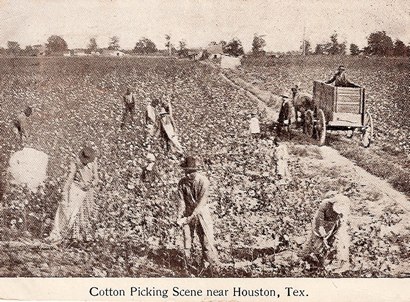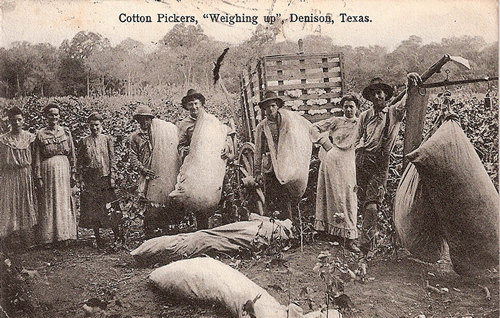| |
More
than seven hundred miles separate Slaton
and the state of Nebraska. The land stretching between the two states and across
the Great Plains, is similar, especially come autumn when the knee-high green
plants spread across wide flat lands and bloom with white gold – Cotton.
Ben Diaz and his family, including a young daughter named Sara who was
thirteen at the time, in search of fieldwork, migrated across the Great Plains
throughout the 1930’s. Sara, who often dressed in blouses made of feed sacks and
pants of heavy material, worked in the fields along with her siblings with their
father standing guard should there be rattlesnakes.
“We pulled cotton,”
Sara said recently from her home filled with statues of saints and pictures of
family members adorning the walls. A television set on a Spanish station was tuned
to a Telanovella in the background. “It’s a lot different from picking cotton.
We would reach down with both arms,” she said, bringing her arms up midway as
if preparing for a hug, “and pulled the cotton with both our arms and filled the
sack. Picking cotton is when you pick the bulbs and clean the seeds out of them.” |
 |
 |
In
the book Slaton’s Story, it is written that Ben, Sara’s father and a native
of Mexico, married Delfina Hernandez in Taylor,
Texas on September 10, 1927. The couple bore seven children, Jesus, Ignacio,
Sara, Joe, Moses, Librado and Juanita. The family migrated during harvest season,
but lived in Thorndale
during their time off while the children attended school for three months out
of the year.
In 1947, as the family made their journey from Nebraska to
Thorndale in South
Texas, as they passed through Slaton,
Ben said to his wife, “I want you to look the town over with me.”
In Slaton,
Ben showed Delfina the town surrounded by cotton.
He showed her the town square, the small shops, and the movie theaters that had
welcomed thousands before.
Two years after World
War II had ended, the town had returned to its small and humble atmosphere.
The troops that once passed through by train were now long gone and were only
memories in post-war Slaton.
“I would like to stay here,” Ben said to his wife as the two discovered the town.
In November of 1947, the Diaz family became Slaton’s
newest residents.
During
their time in Slaton, the
family worked at the Caldwell farm. The children continued working the fields
alongside their father. Sara said it was hard work, but it had to be done. “We
did what daddy said,” she said. As a thirteen-year old girl reared on farm work,
she knew no other life.
Of course, the family found ways to entertain
themselves in the fields and during watermelon season, Sara said they often picked
watermelons and ate them for lunch. “They were so sweet, I can still remember
the taste,” she said.
When the children did have some time off, they made
their way to the theaters on the town square. “Because of the color of our skin,
the only other places, besides the movie theaters, we could walk into was the
grocery store or drug store,” Sara said. Of course, even in the Slaton Theater,
the only place Sara said they were allowed to sit was in the balcony. “We weren’t
allowed to use the concession stand,” she said. “We would have to go to the restaurants
and buy hamburgers to take with us,” even though at the restaurants on the square,
they were only allowed to use back entrances.
During the 1940’s and well
into the 1950’s and 1960’s, Slaton,
like the rest of the southern United States, was dominated by Jim Crow Laws, which
authorized the separation of the use of public facilities between white Americans
and black Americans, lumping dark skinned Mexicans in with the black Americans.
Many restaurants in Slaton
separated their patrons by race and even city hall had separate water fountains
reserved for white citizens and black citizens.
It
was in the late 1940’s when Ben Diaz tried stopping his vehicle before slamming
into a soda machine that sat outside of a filling station in Slaton.
However, his attempt to stop proved futile and he found his vehicle bumping the
soda machine before coming to a complete halt.
The owner of the filling
station was not pleased with the accident and rushed out to chastise Ben.
“You’re
going to have to pay for that,” the man said to Ben as he looked at the damage
with displeasure. “I want $20 for it.”
Ben, accepting the terms, told
the man he would have to go to his house, which was miles away on a farm, and
retrieve the cash. The man told him he would have to leave his car at the filling
station until his return.
As Ben walked across town and out onto highway
leading to his house, a friend of his, Luke Slone, stopped and asked why he was
walking. When Ben told him of the altercation, Luke pulled a twenty-dollar bill
out of his pocket, handed it to Ben, and drove him to the filling station to retrieve
his vehicle.
It
is written in Slaton’s Story, however, that though the family had their struggles
in the new town they did come to know and like some of the people of the town.
“We have acquired many friends through the years and it would be impossible to
mention all of them,” members of the family wrote in the book. “Dad will never
forget the first man in Slaton
to befriend him when he first came to Slaton.
That man is Luke Slone.”
Camaraderie between the community and the Diaz
family slowly grew during their beginning years.
Ben bought their first
home from K.L. Scudder. Within a few years of knowing the family, Scudder approached
Ben with an opportunity to reach out toward the Spanish speaking population of
Slaton, which had grown
during the height of the Bracero Program which began during World
War II. It brought many Mexicans to Slaton
to work in the cotton fields, on the railroads, and various other agricultural
ventures during the times of a weak workforce. The Presbyterian Church wanted
to attract the Spanish speakers and thought Ben was the right man to reach out
toward that community.
“Dad was interested and he started to help by speaking
to the people,” the Diaz family wrote in Slaton’s Story. United in faith, the
people of the Presbyterian Church accepted Ben and he later became a lay preacher.
Of course, their beginnings at the church weren’t as smooth and orderly
as imagined.
When Sara walked into the church one afternoon she noticed
a disdainful look from one of the congregants and then the woman, turning to another
member of the church, said within earshot of Sara. “I don’t like people like that
coming in here.”
Sara turned toward the woman and said, “Rebecca, you’re
supposed to be a Christian and you feel this way about the color of my skin?”
The woman looked down at Sara, shocked by her vigor. “If you go to heaven,” Sara
continued, “there’ll be people who are my color.”
Sara began walking away,
but stopped in her tracks and turned toward the woman and said, “and if you go
to hell, there’ll be some of us there too,” she turned her back and continued
walking.
© James
Villanueva
"They
shoe horses, don't they?" January
30, 2011 Guest
Column
Originally
Published in The Slatonite, Slaton's newspaper | |
|